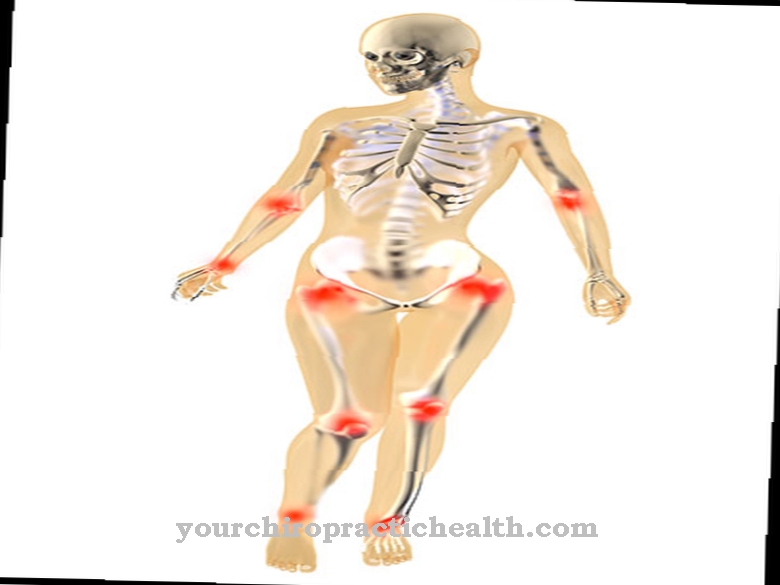Of the Andersen's disease is a particularly severe form of glycogen storage disease. It is a hereditary condition characterized by the formation of abnormal glycogen. The prognosis for the disease is very poor.
What is Andersen's disease?

© ag visuell - stock.adobe.com
In the context of Andersen's disease an unusual form of glycogen is stored. This glycogen has a similar structure to amylopectin, a high percentage of which is found in vegetable starch. Usually glycogen is highly branched. In Andersen's disease, however, there is only a weakly branched polysaccharide.
The disease is characterized by rapid enlargement of the liver, which quickly leads to liver cirrhosis. The abnormal polysaccharide can no longer be broken down and continues to accumulate. The deficiency or even the lack of the enzyme amylo-1,4-1,6-transglucosidase is responsible for the defective glycogen formation. It provides the branching in this polysaccharide molecule.
The disease is very rare, but still occurs in various forms or forms. In the extremely severe form, the child is often stillborn. Lighter forms that begin at a later age have also been described. In any case, however, there is a mutation in gene (GBE1), which is located on chromosome 3.
causes
The cause of Andersen's disease is a genetic defect in gene GBE1 on chromosome 3, which can be inherited as an autosomal recessive trait. This gene is responsible for the synthesis of the enzyme amylo-1,4-1,6-transglucosidase. If this enzyme is missing or if it has only limited functionality, normal glycogen can no longer be synthesized. The enzyme is responsible for the branching of the polysaccharose molecule.
If this branching does not take place or if it is only carried out incompletely, a glycogen is created which can no longer be broken down for a quick energy supply. On the contrary, it accumulates very quickly in the liver, spleen and lymph nodes. After each meal, some of the unused glucose is transported to the liver to store it as a reserve substance, glycogen.
However, this reserve material cannot be used in its present form. The constant accumulation of the abnormal glycogen enlarges the liver and the spleen more and more and inevitably leads to the destruction of both organs.
Symptoms, ailments & signs
Andersen's disease manifests itself through an extraordinary variability. It is about the constant storage of an abnormal glycogen, which can no longer be broken down. But the severity of the disease can be different. Nevertheless, the prognosis for Andersen's disease is very poor overall. The most prominent symptom is a constantly enlarging liver, from which liver cirrhosis quickly develops.
The most severe form shows itself through missing or reduced child movements before birth. The fetus shows signs of joint stiffness and pulmonary hypoplasia. Usually in these cases the child is born dead. In the classic cases, the child is still normally developed at birth. However, in the first few months of life, hepatomegaly (enlarged liver) and hypotonia (lack of muscle tension) develop.
Overall, the child's development is delayed. The disease progresses rapidly. The liver develops cirrhosis. There is also increased portal pressure and the spleen enlarges. Due to cirrhosis of the liver, varices develop in the esophagus with corresponding bleeding and ascites. Death usually occurs in early childhood. In rarer cases, the disease starts later and shows symptoms of muscle weakness and heart failure. Neurological symptoms also occur here.
Diagnosis & course of disease
The diagnosis can be made on the basis of the clinical picture and accompanied by laboratory tests, liver biopsies and molecular genetic tests. In the histological examinations, the intracellular accumulation of stainable amylopectin-like structures is noticeable. The enzyme responsible is examined in the hepatocytes, fibroblasts and leukocytes. A proven deficiency of amylo-1,4-1,6-transglucosidase confirms the diagnosis.
Complications
As a rule, the life expectancy of the child is significantly reduced by Andersen's disease or the child is born dead. This can lead to severe psychological complaints or depression, especially with relatives or parents. In most cases, they are then dependent on psychological treatment.
Affected children suffer from cirrhosis of the liver, which ultimately leads to death. Furthermore, the joints are also stiffened and movements are no longer possible due to this complaint. The mental development of the child is also severely impaired by Andersen's disease, so that those affected are usually always dependent on the help of other people. It is not uncommon for heart failure or muscle weakness to occur.
The patients can also die of cardiac death. Unfortunately, Andersen's disease cannot be cured. The transplantation of a liver can also only relieve the symptoms for a short time, since the damage to the new liver will also occur. This ultimately leads to the death of the child. Until then, however, the complaints and symptoms can be limited with the help of medical measures.
When should you go to the doctor?
Andersen's disease is a genetic disease that, in severe cases, can lead to the death of the fetus in the womb. Therefore, pregnant women should seek medical treatment as soon as irregularities or abnormalities are noticed during pregnancy. If the expectant mother has a vague feeling that something might be wrong with the unborn child, she should consult a doctor. If the newborn survives the first days and weeks after the birth, a doctor is needed as soon as peculiarities become apparent in the further development. If you have muscle weakness or movement disorders, a doctor should be consulted.
Disturbances in growth are signs of an existing disease and must be clarified. Cardiac abnormalities, deformations of the body and discrepancies in child behavior must be examined and treated. In many cases the disease leads to an enlargement of the organs. The liver or spleen in particular are affected in these cases.
Therefore, a doctor is needed as soon as an unusual shape of the upper body occurs in direct comparison with babies or children of the same age. Discoloration of the skin or other irregularities in the skin's appearance are further signs of a health impairment. A yellowish face or eyes should be assessed by a doctor.
Therapy & Treatment
Since the disease is genetic, no causal treatment can be given. Therapy is only symptomatic. As part of treatment, doctors mainly focus on complications that arise. This lowers the pressure in the portal vein circuit. There is also a substitution of albumin and coagulation factors.
If liver failure occurs, a liver transplant can extend life. However, the disease cannot be cured even with a liver transplant. The genetic defect is present and will also lead to deposits of the abnormal glycogen in the new liver. The storage of the defective polysaccharide continues in the other organs of the so-called reticulohistiocytic system of the spleen and lymph nodes, so that serious complications can still occur even after a successful liver transplant.
The reticulohistiocytic system is part of the immune system and includes the cells of the reticular connective tissue. These cells store particles and substances in order to break them down and then carry them out of the body. However, the breakdown of the defective polysaccharose molecules is no longer possible here either.
Outlook & forecast
Andersen's disease has a relatively poor prognosis. The metabolic disease has so far not been curable and causes severe liver damage. In some cases, muscle complaints and concomitant diseases occur which, if left untreated, progressively progress. Life expectancy is severely limited by the condition. Sick children reach an average of two to five years of age. An early liver transplant improves the prognosis. The prognosis is poor, especially for the classic forms of the disease, especially if there is no liver transplant in the first few months of life.
As a rule, the long-term prognosis is based on the extent, severity and progression of the disease. Andersen's disease is one of the most severe glycogenoses. The quality of life is usually greatly reduced due to the liver problems and other symptoms. Pain medication and comprehensive therapy improve the child's well-being, but they are also associated with risks. The liver specialist responsible provides the prognosis.
Life expectancy is severely limited by the condition. Any concomitant illnesses that can occur with undetected diseases are also included in the prognosis. Andersen's disease therefore offers a poor prognosis overall. Novel treatment methods could bring an improvement in the future.
prevention
A prevention of Andersen's disease can only refer to the fact that the offspring do not inherit this disease. Since Andersen's disease is passed on in an autosomal recessive manner, several generations can be skipped in inheritance. If there have already been cases of Andersen's disease in the family and relatives, human genetic testing should therefore be carried out.
If the gene is found in both parents, genetic counseling is recommended. In this case, the offspring has a 25 percent chance of developing Andersen's disease.
Aftercare
Since Andersen's disease cannot be cured, the treatment of the symptoms and the containment of possible complications are the main focus throughout the treatment period. Follow-up care is necessary after interventions that are carried out as part of the therapy. If a liver transplant occurs, professional follow-up care is very important for it.
After the procedure, this ensures that the new liver is not rejected by the body. Special drugs suppress the body's immune response. As a result, however, the body's resistance to pathogens is weakened, which must be taken into account in further therapy. During this time, the patient must have regular blood tests. Care is taken to ensure that there are no rejection reactions or other serious complications such as kidney dysfunction, which can occur as side effects.
While the core symptoms of Andersen's disease can be improved directly after a liver transplant, the deposition of the defective glycogen continues, so that complications and progressive symptoms must be expected even after a transplant. The liver specialist responsible can provide more detailed information on the prognosis and the further course of treatment.
You can do that yourself
The self-help measures a patient with Andersen's disease can take are limited to nonexistent. Since the disease has genetic causes and cannot be controlled despite symptomatic treatment, the possibilities of the person affected quickly become exhausted. He is best advised to take any diet and lifestyle advice given by his treating doctor seriously and to implement it.
Furthermore, after a liver transplant, the person affected should consider gentle behavior. Alcohol, fatty foods and exertion should be avoided. This makes it easier for the body to really accept the new organ. However, a successful transplant, including successful follow-up care, cannot stop type 4 glycogenosis itself.
Since this is an autosomal recessive inherited disease (it can skip several generations), it makes sense to have a genetic profile drawn up when planning a family. While those affected by Andersen's disease already know about their gene, an analysis in this regard is particularly worthwhile for family members. In this way, the transmission of the triggering gene can be prevented through appropriate family planning. At least, however, a certainty can be obtained about the risk of disease in one's own offspring.



























